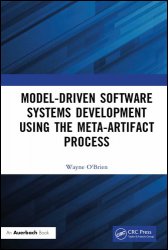Model-Driven Software Systems Development Using the Meta-Artifact Process
- Добавил: literator
- Дата: 5-02-2024, 16:23
- Комментариев: 0
 Название: Model-Driven Software Systems Development Using the Meta-Artifact Process
Название: Model-Driven Software Systems Development Using the Meta-Artifact ProcessАвтор: Wayne O’Brien
Издательство: CRC Press
Год: 2024
Страниц: 145
Язык: английский
Формат: pdf (true)
Размер: 10.1 MB
The importance of architecture for software systems is widely accepted, but the role of architecture in the overall development process is not so clear. Presenting an architecture-centric process, Model-Driven Software Systems Development Using the Meta-Artifact Process makes the role of architecture clear. At its core, this book is about developing software systems and, more specifically, software code. It describes three major innovations for making software, which are combined with five widely used enabling technologies, to provide a complete, hypothesis-driven software development process known as Meta-Artifact Process (MAP). Having complete requirements is essential for making good software and supports the hypothesis-driven MAP.
MAP offers properties, qualities, and capabilities that help stakeholders and developers understand and reason about a domain and target systems of interest. MAP, through the central role of the Meta-Artifact and incorporating the view that a computer program is a hypothesis about the requirements, offers new ways to look at systems and their development, even changing the roles of developers and stakeholders.
Recommending agile methods wherever appropriate while supporting the OMG Essence standard and working within an overarching architecture, MAP presents ways to ensure that the requirements are complete and correct. It helps to identify likely points during development to form alternative hypotheses about them. Because MAP requires an underlying software development process, it can provide that clarity to existing processes in which the organization’s developers are already proficient.
Computer programming is at the heart of Somputer Science. It is the implementation portion of software development, application development and software engineering efforts, transforming ideas and theories into actual, working solutions. As with mathematics, computer programming is analytical, logical, and at times, creative. Viewed as a hypothesis, a computer program is also scientific. It predicts that certain results will be produced and certain qualities that are consistent with the requirements will be exhibited when tested with specified data. In this sense, the requirements are the reality on which the program (hypothesis) is based.1 This aspect of requirements emphasizes that getting the requirements right is crucial. As Einstein explained in his theory of relativity, reality in some circumstances is far different than reality in other circumstances. This book incorporates multiple ways to find requirements in difficult circumstances. It spends much time on ways to ensure that the reality is complete and correct and identifies likely points during development to form alternative hypotheses (throughout the text, as well as the Step Summary and the Diagram of Steps), which may range from algorithms, to architecture, to displays and documents.
Model-Driven Software Systems Development Using the Meta-Artifact Process, a guide for making software (MSW) can be used for large or small systems, using agile methods wherever appropriate, while supporting the OMG Essence standard, and working within an overarching architecture. MSW is concerned in particular with software systems, specifically software codes. Unless specified otherwise, the words system or software or program or code refer to this software code. In some references to hypotheses, program is used as including all aspects of a software system, such as its architecture.
MSW works in conjunction with an organization’s existing processes, especially Model-Driven Development (MDD). Some familiarity with MDD is useful but not essential to understand the ideas. However, if you are already an MDD practitioner, you can begin applying the Meta-Artifact Process (MAP), which underlies MSW, immediately (see Chapter 7). As a middle ground, some of the subheadings are appended with “Detailed Discussion” and may be safely skipped if you are otherwise an experienced practitioner and you want a shortcut to applying the procedure.
This book provides concrete examples from two broad but diverse areas—Accounting Information Systems in the commercial area and a military command and control system—to show the wide applicability of MAP in both commercial and defense domains.
Скачать Model-Driven Software Systems Development Using the Meta-Artifact Process
Внимание
Уважаемый посетитель, Вы зашли на сайт как незарегистрированный пользователь.
Мы рекомендуем Вам зарегистрироваться либо войти на сайт под своим именем.
Уважаемый посетитель, Вы зашли на сайт как незарегистрированный пользователь.
Мы рекомендуем Вам зарегистрироваться либо войти на сайт под своим именем.
Информация
Посетители, находящиеся в группе Гости, не могут оставлять комментарии к данной публикации.
Посетители, находящиеся в группе Гости, не могут оставлять комментарии к данной публикации.
